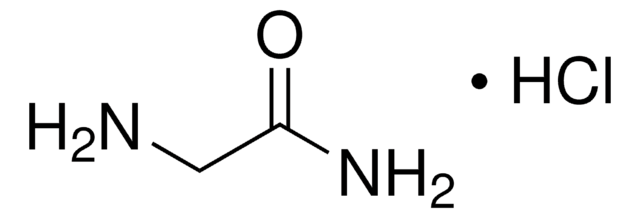8.22336
Thioglycolic acid
for synthesis
Synonim(y):
Thioglycolic acid, Mercaptoacetic acid, 2-Mercaptoethanoic acid
About This Item
Polecane produkty
ciśnienie pary
0.1 hPa ( 20 °C)
Poziom jakości
Postać
liquid
siła działania
73 mg/kg LD50, oral (Rat)
pH
1 (20 °C in H2O)
tw
220 °C/1013 hPa (decomposition)
mp
-16.5 °C
temp. przejścia
flash point 131.5 °C
gęstość
1.325 g/cm3 at 20 °C
temp. przechowywania
2-8°C
InChI
1S/C2H4O2S/c3-2(4)1-5/h5H,1H2,(H,3,4)
Klucz InChI
CWERGRDVMFNCDR-UHFFFAOYSA-N
Zastosowanie
- Biocompatible Drug Delivery Films: Thioglycolic acid enhances the film-forming ability and bioadhesiveness of mucilaginous polysaccharides derived from Cassia uniflora seeds. This innovation is pivotal in drug delivery applications, offering controlled release and improved mucosal adhesion properties (Deore et al., 2024).
- Surface Plasmon Resonance in Nanoparticle Research: The interfacial reactivity of gold nanoparticles can be inferred via surface plasmon resonance measurements, with thioglycolic acid playing a crucial role in modifying nanoparticle surfaces to enhance their reactive properties. This is significant for advancements in nanotechnology and material sciences (Romain et al., 2023).
- Enhanced SERS for Virus Detection: Thioglycolic acid contributes to the fabrication of flexible electrospinning nano-fiber membranes that are pivotal in the detection of respiratory tract transmission viruses using Surface Enhanced Raman Scattering (SERS). This application is crucial in improving public health surveillance and response systems (Sun et al., 2024).
Komentarz do analizy
Density (d 20 °C/ 4 °C): 1.325 - 1.335
Identity (IR): passes test
The assay stated on the certificate of analysis refers to the date of examination. A gradual substance-specific content reduction, especially at higher temperatures, must be expected. The average content reduction at the required storage temperature of +2°c to +8°C is about 1% per month.
Hasło ostrzegawcze
Danger
Zwroty wskazujące rodzaj zagrożenia
Zwroty wskazujące środki ostrożności
Klasyfikacja zagrożeń
Acute Tox. 3 Dermal - Acute Tox. 3 Inhalation - Acute Tox. 3 Oral - Eye Dam. 1 - Skin Corr. 1B - Skin Sens. 1B
Kod klasy składowania
6.1C - Combustible, acute toxic Cat.3 / toxic compounds or compounds which causing chronic effects
Klasa zagrożenia wodnego (WGK)
WGK 1
Temperatura zapłonu (°F)
266.0 °F - closed cup
Temperatura zapłonu (°C)
130 °C - closed cup
Certyfikaty analizy (CoA)
Poszukaj Certyfikaty analizy (CoA), wpisując numer partii/serii produktów. Numery serii i partii można znaleźć na etykiecie produktu po słowach „seria” lub „partia”.
Masz już ten produkt?
Dokumenty związane z niedawno zakupionymi produktami zostały zamieszczone w Bibliotece dokumentów.
Klienci oglądali również te produkty
Nasz zespół naukowców ma doświadczenie we wszystkich obszarach badań, w tym w naukach przyrodniczych, materiałoznawstwie, syntezie chemicznej, chromatografii, analityce i wielu innych dziedzinach.
Skontaktuj się z zespołem ds. pomocy technicznej















